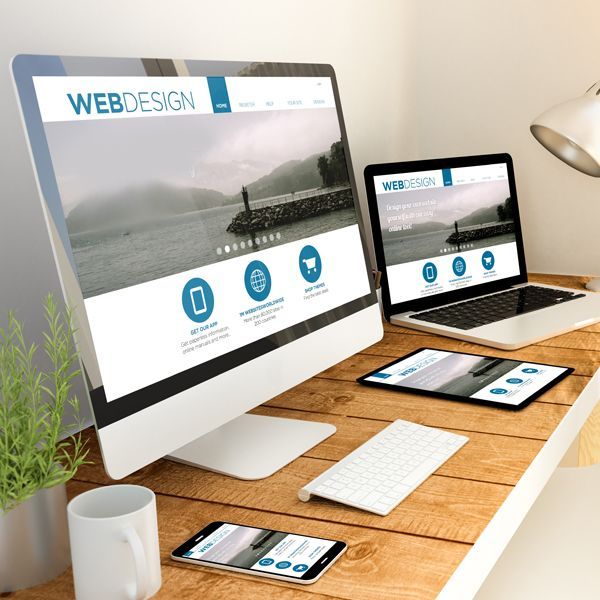Strategic Web Design NY - Nassau County Web Designers
Creative and Strategic Web Designs Based On the Marketing Goals of Your Company by a Company with Over 25 Years of Web Design Experience
Executive Summary
Most web designers will use an existing template and fill it in with your business information. It's cheap, quick, and you'll look like everyone else you're competing with in your service area. We want to make you stand out!
Think of your website's design as a coloring book. We don't add your company colors to an existing design. We create a strategic design based on the objectives of your business.
Our website designs are equally appealing for marketing purposes, which help get you ranked, and the visitor experience, which helps you generate new leads and clients. Please contact us and let's see if we are a fit for each other.

Jump To Section
What is Strategic Web Design?
Strategic web design refers to the approach of creating websites with a clear understanding of the goals and objectives of the business or organization they represent. It involves thoughtful planning and consideration to ensure that the website is not only visually appealing but also aligns with the overall business strategy.
Websites can have various goals depending on their purpose and intended audience. Here are some examples of common goals for websites:
- Information Sharing: Websites aim to provide useful and relevant information to their users. This can include blogs, news websites, educational portals, or reference sites.
- E-commerce: Websites designed for selling products or services online. The goal is to drive conversions and generate revenue.
- Lead Generation: Websites that focus on capturing potential customer information (such as email addresses) to facilitate future communication and marketing efforts.
- Brand Awareness: Websites can serve as a digital representation of a brand, providing information about its values, mission, and offerings to increase visibility and recognition.
- Community Building: Some websites aim to create a sense of community by encouraging user engagement and interaction. Forums, social networks, or online support groups are examples of such websites.
- Conversion of Visitors: Websites focused on converting visitors into taking specific actions, such as signing up for a newsletter, downloading an app, or making a purchase.
- Entertainment and Engagement: Websites that aim to entertain users with multimedia content, games, quizzes, or interactive features. These websites often prioritize user engagement and time spent on the site.
Strategic Web Design Client Testimonial
"I have been doing business with Craig and Nassau County Web Designers for almost 15 years. My business is at the top of all the search results for clients who are looking to use my services, and I get an impressive steady steam of qualified leads every month.
This company knows what they are doing, they are not expensive, and they didn't just change my career, they changed my life!
-E. Wood
Massage Therapist
- Education and Training: Websites designed to provide educational resources, courses, or training materials to help users develop new skills or expand their knowledge on a topic.
A website can have multiple goals simultaneously, and the specific goals will depend on the purpose of the website and the needs of its target audience.
In strategic web design, key factors such as user experience, functionality, and usability are taken into account. The design decisions are made keeping in mind the target audience, the purpose of the website, and the desired outcomes. This approach helps in creating websites that not only look good but also serve their intended purpose effectively.

Responsive Web Design
Responsive web design is an approach to designing and coding websites that ensures optimal viewing and interaction across various devices and screen sizes. With responsive design, a website layout adapts and adjusts automatically to fit different devices like desktop computers, laptops, tablets, and smartphones. We make you look good everywhere!
The key principle of responsive design is to create a flexible and fluid layout that uses CSS (Cascading Style Sheets) media queries and flexible grids to dynamically rearrange and resize website elements based on the user's screen size. This allows the website to provide an optimal user experience regardless of the device being used.
For example, in responsive design, text and images may reflow and resize to fit the screen, navigation menus may collapse into a drop-down format for mobile devices, and the overall layout may adjust to ensure readability and usability.
By implementing responsive web design, websites can provide a consistent and user-friendly experience across all devices, eliminating the need for separate mobile versions or dedicated apps. It helps cater to the growing number of users accessing the internet through mobile devices and ensures that the website remains accessible and functional for all users, regardless of their preferred device.
The Strategic Elements of a Web Page
A web page typically consists of several elements that work together to create its structure and content. Here are some common elements you'll find on a web page:
- HTML (Hypertext Markup Language): It provides the structure of the web page and defines the elements within it.
- CSS (Cascading Style Sheets): CSS is used to control the appearance and layout of the web page. It specifies how HTML elements should be displayed.
- Header: The header usually contains the title of the page, navigation menus, logos, and other introductory information.
- Body: The body of the web page contains the main content, such as text, images, videos, and interactive elements.
- Sections: Web pages can be divided into sections, each representing a distinct block of content. Sections can have headings, paragraphs, lists, and other structural elements.
- Links: Hyperlinks allow users to navigate between different pages or sections within a page. They connect web pages together and enable users to access related content.
- Images: Pictures and graphics can be embedded in a web page to enhance its visual appeal or provide more information. All the images we use on your website are licensed for commercial use.
- Forms: Web pages often contain forms that allow users to input and submit data, such as contact forms, search boxes, or signup forms.
- Footer: The footer is located at the bottom of the page and typically includes additional information, copyright notices, and links to relevant resources.
These are just some of the fundamental elements you'll find on a web page. With the continuous evolution of web technologies, there are also advanced features like JavaScript interactivity, multimedia elements, and dynamic content that can further enrich the web page experience.

Custom Copywriting with SEO
One of the reasons most business owners don't create or update their website is because they think they have to write content. We write all the content for you!
We use a classic sales approach to write your content: Create Interest, Educate, and Close. This style has proven to engage your website visitors and is much more difficult to accomplish than it appears.
Your website content must be 100% unique, or the site will be banned by the search engines. They don't have any patience for stolen intellectual property. Content is equally important for search engines, so we write for their requirements too.

Licensed Photography and Video
Photography and video tell the story of your business before a visitor has to read anything. Often, web visitors use art to determine if they are at the right website.
Using licensed photography and video for websites is important for several reasons. Firstly, using licensed content ensures that you are not infringing on someone else's intellectual property rights. It respects the rights of the content creators and helps support their work.
Secondly, licensed photography and video typically have higher quality and professionalism compared to unlicensed or free alternatives.
Furthermore, using licensed content helps you avoid legal issues. Unauthorized use of copyrighted material can lead to legal consequences, including copyright infringement claims and potential financial penalties. We've seen companies get fines as high as $2,600 for each violation, and deleting the images doesn't make the problem go away. By using licensed photography and video, you minimize the risk of facing legal disputes and maintain a positive reputation for your website.
Lastly, licensing content supports the creative industries. Photographers, videographers, and other content creators rely on their work to make a living. By paying for licensed content, you contribute to sustaining the creative community and encouraging further innovation.
Overall, using licensed photography and video for websites ensures legal compliance, improves the quality of your content, and supports the creativity of the artists behind the works. All the art, photography, and video we use on your website are high-quality and licensed for use.

SEO - Search Engine Optimization
Having SEO (Search Engine Optimization) as part of strategic web designs is crucial for several reasons. Firstly, SEO helps increase the visibility of your website in search engine results pages (SERPs).
When people search for relevant keywords or phrases related to your business or content, a strong SEO strategy can ensure that your website appears higher in the search rankings. This visibility can generate more organic traffic and potentially lead to increased conversions and business opportunities.
Secondly, SEO helps improve the user experience on your website. A good SEO strategy involves optimizing website
structure, navigation, and content to ensure that it's easily accessible and understandable for both users and search engines. This can positively impact factors such as page loading speed, mobile-friendliness, and overall site usability, thereby enhancing the user's experience and encouraging them to stay longer on your website.
Furthermore, SEO is closely tied to online marketing and branding efforts. By implementing effective SEO techniques, you can target specific keywords and phrases that align with your business goals and attract the right audience to your website. This helps build brand awareness, credibility, and authority in your industry, as well as establishes your website as a reliable source of information or products/services.
Lastly, integrating SEO into strategic web designs allows you to keep up with evolving search engine algorithms and industry trends. SEO is a dynamic field, and search engines regularly update their algorithms to provide the most relevant and high-quality results to users. By staying up-to-date with SEO best practices, website owners can ensure that their website remains optimized for search engines, maintains its rankings, and continues to attract organic traffic.
Overall, incorporating SEO into strategic web designs is important because it enhances visibility, improves user experience, strengthens branding efforts, and helps websites adapt to changing search engine algorithms.
Learn more about our SEO Agency.
Contact Us for a Free Consultation
Whether you're a new business, or you want to update your current online marketing program, we can help you choose the best path for your company. It all starts with a custom design for your business goals, budget, and a free consultation.
Please contact us today.

